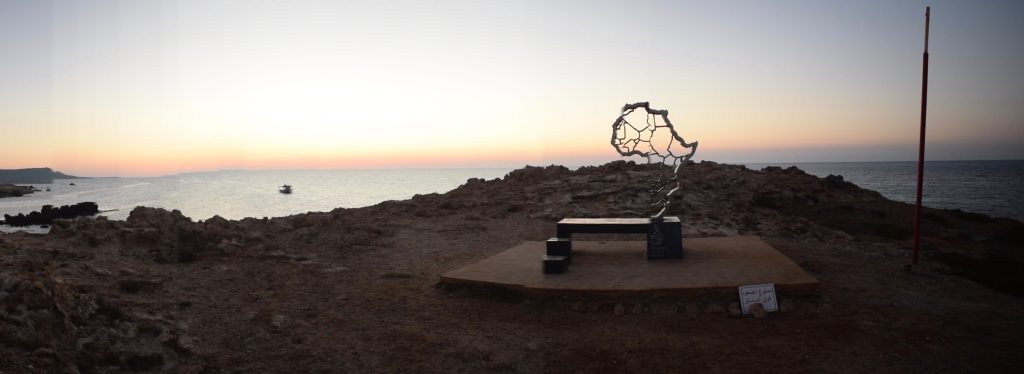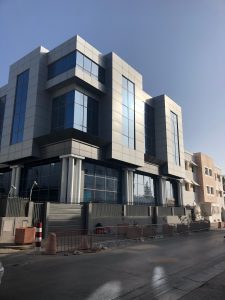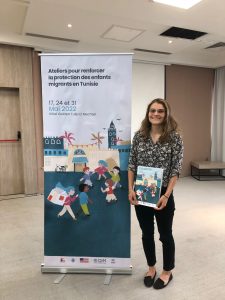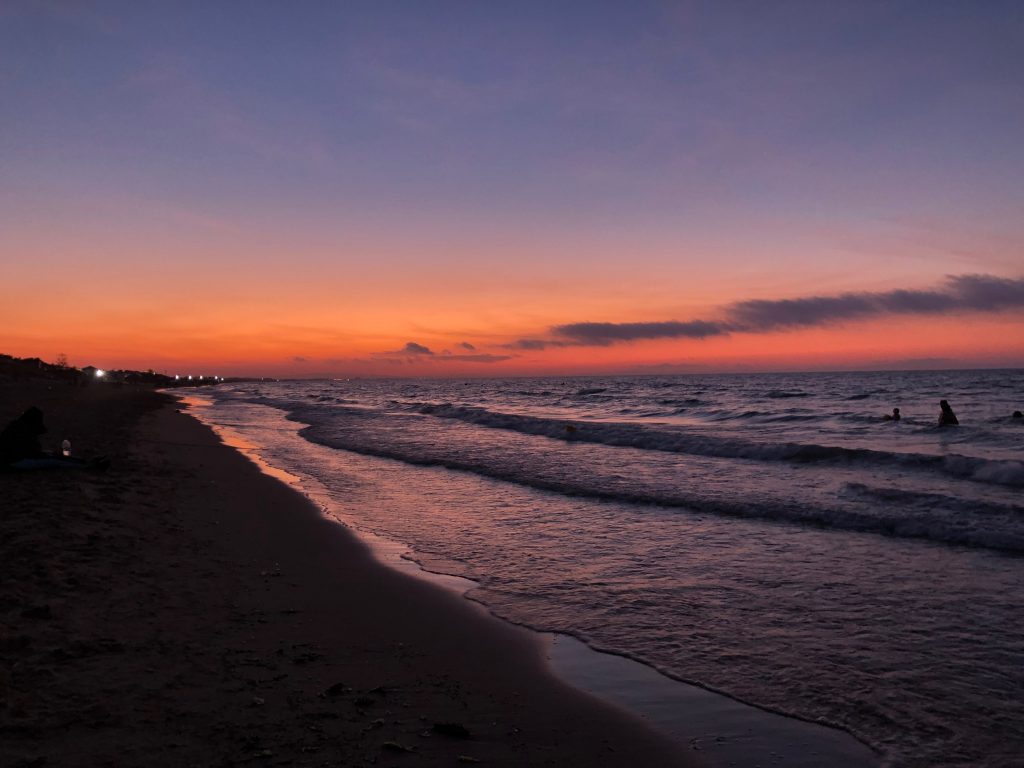by Laurence LeBlanc
NOTE: The views in this article are my own and by no way representative of the positions held by UNHCR Tunisia. Due to confidentiality obligations, the information gathered for this article came from NGOs and informal interviews with protesters.

“We have had enough,” reads a protester sign in front of the United Nations High Commissioner for Refugees (UNHCR) office in Tunis. A young man who looks to be about 16 years old holds the cardboard sign written in Arabic, chanting in a line with about fifteen other single young men demanding to be resettled in Europe. He wears a t-shirt, jeans, and flip flops. Behind him are tarps flapping in the wind, made of garbage bags covering make-shift shelters held down by rope. We make brief eye contact as sweat pours down his face. I skirt by in my professional attire, making my way to a side street which opens to the backside of the UNHCR building with a view of the Lake of Tunis. The security guards recognize me, open the doors, and I place my backpack on the x-ray machine.

As a Canadian student in her mid-twenties interning with the UNHCR protection team in an air-conditioned office, I do not claim to know as much about this struggle as the 16-year-old who walked here through the Sahara Desert from Sudan currently protesting in mid-summer Tunisian heat. Neither do I claim to understand the struggles of the Somalian mother I saw breastfeeding her child in 38°C (100°F) weather, nor that of the Ivorian migrant who joined the protest in an effort to escape the application of a cessation clause from Geneva which would effectively revoke his asylum seeker claim – after four years of waiting for a response. I only offer my insight as a law student and observer with a glimpse on a protest this summer.
This post discusses the humanitarian and political considerations interwoven in the asylum seeker protest outside the UNHCR Tunis office from the months of April to July, 2022. While small in scale, the protest is a microcosm for understanding larger sociopolitical constraints facing asylum seekers across North Africa, and is an example of asylum seeker agency in demanding alternatives to our current refugee law paradigm.
Protest Background:
There are two UNHCR offices in Tunisia, one in Zarzis in the South of the country and one in Tunis in the North. Since February of 2022 a group of around 220 asylum seekers and refugees who were living in Zarzis started receiving reduced monthly support payments from the Zarzis office because of UNHCR budget cuts higher up. Considering the Zarzis POCs (“people of concern,” which includes refugees, asylum seekers, returnees, and internally displaced people) receive a slightly higher stipend than those in Tunis, the reduction was felt quite starkly in Zarzis at the time. After unsuccessfully protesting outside of the Zarzis office for two months demanding resettlement, the group of protesters found their way North to Tunis in April. They set up camp right on Rue du Lac Biwa in front of the UNHCR office.
The UNHCR office is in Lac 1, the diplomatic district of Tunis. The protest created shockwaves in terms of political pressure, considering it was just a few streets from The International Organization for Migration (IOM), the European Union, the German and Swedish Embassies, and upper-class hotels. These protesters picked the right place. According to conversations with NGOs, there was an unofficial threat from Tunisian officials to close borders if this situation didn’t come under control soon—which would have been detrimental to vulnerable people entering the country from neighbouring Algeria and Libya—so the UNHCR protection team was pressured to come up with a solution fast.
 The solution that the team came up with was essentially to create an emergency shelter until these applicants had their applications processed. This was a controversial decision, but I came to realize it was realistically one of the only options that made sense considering the political pressures on all sides. It was controversial because there are already around 6000 recognized refugees in Tunis, with only about 40 places for sheltered accommodation. Why should these newcomers – some of whom had not passed the vulnerability assessment to become refugees – get to skip the line while waiting for their assessment? On the other hand, how could the UNHCR leave these people outside protesting after four months on the street with health outbreaks and heat waves? The decision was controversial because the shelter project absorbed a huge percentage of the yearly budget, therefore potentially reducing resources for other vulnerable refugees and asylum seekers in Tunisia.
The solution that the team came up with was essentially to create an emergency shelter until these applicants had their applications processed. This was a controversial decision, but I came to realize it was realistically one of the only options that made sense considering the political pressures on all sides. It was controversial because there are already around 6000 recognized refugees in Tunis, with only about 40 places for sheltered accommodation. Why should these newcomers – some of whom had not passed the vulnerability assessment to become refugees – get to skip the line while waiting for their assessment? On the other hand, how could the UNHCR leave these people outside protesting after four months on the street with health outbreaks and heat waves? The decision was controversial because the shelter project absorbed a huge percentage of the yearly budget, therefore potentially reducing resources for other vulnerable refugees and asylum seekers in Tunisia.
Finger pointing came from all sides. In the eyes of NGOs, the UNHCR wasn’t doing enough : the shelter was far from the central downtown region, was too crowded, and didn’t have fans. How could they not provide fans in 40-degree weather? In the eyes of the UNHCR employees scrambling for resources and not sleeping enough, UNHCR was doing as much as they could considering the budget was constrained, their legal mandate was restricted, and if they started handing out fans here and not in other shelters, then more people would show up and the problem would explode. In fact, after the original protesters were moved to the temporary shelter, new people living in Tunis – including refugees, asylum seekers, and economic migrants – started protesting at the office, too. Bystanders had mixed feelings depending on who they talked to and which stories they heard.
One of the most fascinating aspects of this protest was appreciating the various perspectives involved: the asylum seekers, UNHCR headquarters, UNHCR Tunisia, NGOs speaking to refugees, the municipality, the police, the media. Furthermore, each of these actors can be split up into various organizations, departments, and individuals. Although refugees are often grouped into nationalities for statistical reasons, their stories are wildly different, and generalizations can paint simplistic stories out of complex human lives.

Completing an unpaid internship with the UNHCR this summer was deeply rewarding. From meeting inspiring colleagues, hearing gut-wrenching conundrums about statelessness, drafting legal decisions on cases, doing legal research about cessation clauses, attending conferences about child migrant rights, hosting a meeting between the IOM and UNHCR to address boat arrivals from Libya… and so on, one particularly interesting responsibility vis-a-vis the protest stands out. I contributed to a letter responding to an open-letter from NGOs critiquing the UNHCR for their protest response. This was fascinating because I had only ever worked for NGOs similar to those I was responding to, and if I hadn’t been cautious to holistically appreciate UNHCR’s role I would have most likely jumped on the NGO bandwagon without considering the important points (if I do say so myself!) made in the UNHCR response.
Legal Context:
A bit of legal context clarifies why a protest like this one brings so many humanitarian dilemmas to light. The three most important legal texts concerning the UNHCR are its Statute, the 1951 Refugee Convention, and the 1967 Protocol. Together, these texts (plus regional instruments) comprise the international legal landscape which the UNHCR works from.
The 1950 UNHCR Statute tasks the institution with the responsibility to provide international protection and assist governments in finding permanent solutions for refugees. The 1951 Convention on the Status of Refugees defines the term “refugee,” outlines the rights of the displaced and the legal obligations of States to protect them. Originally meant to address an estimated 1.2 million refugees who were still forcibly displaced following the Second World War, the 1967 Protocol relating to the Status of Refugees removed geographical and temporal restrictions from the 1951 Refugee Convention. Basically, that just means we can use the Convention today.

The terms “refugee” and “asylum seeker” are legal terms which impact what kinds of assistance people are eligible to receive from the UNHCR. According to the 1951 Convention, a refugee is someone who is unable or unwilling to return to their country of origin owing to a well-founded fear of being persecuted for reasons of race, religion, nationality, membership of a particular social group, or political opinion. When a person flees their own country for safety in another country, they are said to be seeking asylum and are known as an asylum-seeker. Asylum seekers apply for refugee status, which is determined by a legal process called refugee status determination, or “RSD”, by which governments or UNHCR determine whether a person seeking international protection is considered a refugee. In Tunisia, UNHCR does RSD because the Tunisian government does not have a system in place, even though they are still considered a “safe country,” by the international community.
As an important side note, both refugees and asylum seekers must be claiming status outside their state of origin. This means that internally displaced persons (IDPs), unlike refugees, are displaced within their own countries. Stateless persons, who may or may not be refugees, are not considered to be nationals by any state, due to lack of registration or arbitrary deprivation of citizenship, for example, which makes accessing services much more difficult. (Think: somebody born in the desert between Libya and Tunisia who doesn’t know which territory they were born on). Finally, a migrant is a person who moves to another country but does not fit into the above categories, often to better their standard of living.
These categories tend to create the impression that people can easily be classified into legal regimes, but in practice, individuals choose to leave their place of residence for multiple, overlapping motivations. The fact the RSD process can be so tedious is evidence that categorizing people into legal categories is not always easy.
One of the legal difficulties of this protest was that the protesters were demanding resettlement. Resettlement is the transfer of refugees from an asylum country to another state, almost wholly dependent on that receiving state’s collaboration in the process. In other words, Canada can put caps on how many resettled refugees it accepts, and can even decide which sending countries it will not consider applications from. UNHCR has to tiptoe between state sovereignty, which is sometimes quite arbitrary, and its own protection mandate when it comes to resettlement. The resettlement process is selective and rigorous.
The fact that 200+ people were demanding resettlement outside of the UNHCR office demonstrates a few things. Firstly, when there is even a tiny hope to get resettled, people will latch onto it. Secondly, there might be misinformation (including between protest leaders and the protesters following their lead) when it comes to understanding resettlement processes. Thirdly, it suggests that the legal conventions we have in place are inadequate. In order to be resettled in Europe, these protesters would first have to be assessed to be refugees, and secondly, they would have to fall into the less than 1% of refugee cases accepted for resettlement from Tunisia. Thousands of people make the dangerous journey across the Mediterranean sea each year because desperation and hope, and no other practical alternatives, drive life-threatening choices. There must be a better way.
The injustices of global governance were at the forefront of my mind throughout my time in Tunisia. Why can Europeans live in North Africa without much fuss, but people who have quite literally walked across the Sahara desert have restricted chances of ever seeing European soil, even as tourists? The fact that 80% of visa applications to France from Tunisia are refused, but the French don’t need visas to go to Tunisia, demonstrates the imbalance in bargaining power when it comes to immigration laws.

Humanizing humanitarianism
I learned that there is no “good guy” and no “bad guy” in humanitarian law, as I often prefer to simplify. The UNHCR is mandated to deal with a tiny fraction of people on the move, which is necessary considering the immense work to be done. However, this can also be extremely frustrating considering non-refugees are often afforded less resources because of technicalities beyond their control. Sometimes the line between refugee and asylum seeker is quite thin, despite handbooks detailing the streamlined process. The lack of practical solutions for a large number of people who do not qualify as refugees – and even those who do – demonstrates that the system is in need of revamping. The ongoing protests are a clear indication that things aren’t working.

I’m not claiming to know how to fix it, considering “fix” and “it” are PhD dissertation topics already approached from hundreds of perspectives. This said, my first gut reaction is that humanitarianism must be humanized. By this, I refer to the fact that humanitarian decision-making at the upper levels of policy can dehumanize the very beneficiaries they attempt to be assisting. “Humanizing humanitarianism,” as I call it, might mean stepping back and recognizing the politics that come into play when it comes to refugee law. Decisions are made about huge swaths of people who are generalized into categories that may not be justified, especially considering geo-political power tilts. After all, the EU funds a large part of the UNHCR budget, and EU migration policies are some of the least humanizing exercises I’ve heard of. By way of example, the EU provides the state of Tunisia with development funding in order to patrol the seas and ultimately reduce arrivals to Europe. Problematic? Quite.
Considering asylum seekers as criminal villains dehumanizes them, but so too does considering asylum seekers as rule-following angels. Asylum seekers are human beings, and either of these extremes reduces a practical engagement with their goals and aspirations. While students in international development sometimes put refugees on a moral higher ground than the institutions which make laws regulating them (or at least I used to unintentionally), I realized that this can actually be counter-productive to humanizing those seeking asylum. I met dozens of resourceful human beings who strategically try to make the most of existing systems, despite the fact that existing systems are sometimes not adequate structures to respond to their needs.
In closing, individuals have every right to aspire for a better life. Protesting outside the UNHCR office in Tunis and demanding change is one strategy employed by asylum seekers to do just that. Whether or not the change they are demanding will ever come to fruition, and whether or not the UNHCR can even respond to such demands considering legal constraints, is yet to be determined. One thing for sure is that taking these protests seriously is key in envisioning solutions to complex problems and being one step closer to humanizing the dehumanized, which is necessary for durable solutions going forward.
